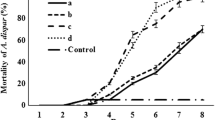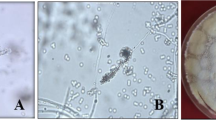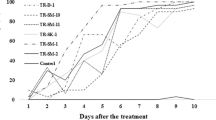Abstract
The invasive ambrosia beetle, Xylosandrus germanus Blandford (Coleoptera: Curculionidae: Scolytinae), is a serious pest of hazelnut in Turkey, which is the biggest hazelnut producer in the world. In this study, the utility of four isolates representing different Trichoderma species (T. harzianum, T. hamatum, T. asperellum, and T. atroviride) was evaluated on survival, gallery behavior and brood production of X. germanus by effecting the symbiotic fungal development at laboratory conditions. Hazelnut branches were exposed to fungal suspensions (1 × 106 and 1 × 108 conidia mL−1 doses) for about 30 s. and transferred to individual plastic boxes. Ten healthy females of X. germanus were released into each box to determine the effect of the treatment of mycoparasite isolates. The antagonistic effect of Trichoderma species on symbiotic fungus was evaluated in dual-culture experiments in Petri dishes. The survival and gallery production of the pest were not directly affected by treatment of two different doses of all four Trichoderma species. The growth of the symbiotic fungus, however, was suppressed significantly by Trichoderma isolates in beetle galleries as well as on Petri dishes. Moreover, symbiotic fungal growth and eggs, larvae, and pupae of the beetle were not observed in the galleries carved out by females within the branches treated with two concentrations of T. harzianum, T. asperellum, and T. atroviride. Some of the galleries in the branches treated with T. hamatum had very sparse mycelial growth and fewer broods compared to the control. Our findings showed that the Trichoderma species may be potential biological control agents against X. germanus.


Similar content being viewed by others
References
Abbas A, Jiang D, Fu Y (2017) Trichoderma spp. as antagonist of Rhizoctonia solani. J Plant Pathol Microbiol 8:402
Agnello AM, Breth DI, Tee EM, Cox KD, Villani SM, Ayer KM et al (2017) Xylosandrus germanus (Coleoptera: Curculionidae: Scolytinae) occurrence, fungal associations, and management trials in New York apple orchards. J Econ Entomol 110:2149–2164
Ak K, Saruhan I, Tuncer C, Akyol H, Kılıç A (2011) Ambrosia beetles (Coleoptera: Scolytidae) species and their damage ratios in Kiwi orchards of Ordu Province, Turkey. Turk Bull Entomol 1(4):229–234
Anderson RL, Hoffard WH (1978) Fusarium canker ambrosia beetle complex on tulip poplar in Ohio. Plant Dis Rep 62:751
Battilani P, Chiusa G, Arciuolo R, Somenzi M, Fontana M, Castello G, Spigolon N (2018) Diaporthe as the main cause of hazelnut defects in the Caucasus region. Phytopathol Mediterr 57(2):320–333
Bell DK, Wells HD, Markhan CR (1982) In vitro antagonism of Trichoderma species against six fungal pathogens. Phytopathology 72:379–382
Biedermann PHW (2007) Social behavior in sib mating fungus farmers (Master’s thesis). University of Berne, Berne
Bucini D, Balestra GM, Pucci C, Paparatti B (2005) Bio-ethology of Anisandrus dispar F. and its possible involvement in Dieback (Moria) diseases of hazelnut (Corylus avellana L.) plants in central Italy. Acta Hortic 686:435–439
Castrillo LA, Griggs MH, Vandenberg JD (2013) Granulate ambrosia beetle, Xylosandrus crassiusculus (Coleoptera: Curculionidae), survival and brood production following exposure to entomopathogenic and myco-parasitic fungi. Biol Control 67:220–226
Castrillo LA, Griggs MH, Vandenberg JD (2016) Competition between biological control fungi and fungal symbionts of ambrosia beetles Xylosandrus crassiusculus and X. germanus (Coleoptera: Curculionidae): mycelial interactions and impact on beetle brood production. Biol Control 103:138–146
Erper I, Turkkan M, Atanasova L, Druzhınına IS, Karaca GH, Cebi-Kilicoglu M (2013) Integrated assessment of the mycoparasitic and phytostimulating properties of Trichoderma strains against Rhizoctonia solani. Bulgar J Agric Sci 19:742–748
Farrell BD, Sequeira AS, O’Meara BC, Normark BB, Chung JH, Jordal BH (2001) The evolution of agriculture in beetles (Curculionidae: Scolytinae and Platypodinae). Evolution 55:2011–2027
Francke-Grosmann H (1967) Ectosymbiosis in wood-inhabiting insects. In: Henry SM (ed) Symbiosis. Academic Press, New York, pp 142–206
French JR, Roeper RA (1972) Interactions of the ambrosia beetle, Xyleborus dispar (Coleoptera: Scolytidae), with its symbiotic fungus Ambrosiella hartigii (Fungi: Imperfecti). Can Entomol 104:1635–1641
Galko J, Dzurenko M, Ranger CM, Kulfan J, Kula E, Nikolov C et al (2019) Distribution, habitat preference, and management of the invasive ambrosia beetle Xylosandrus germanus (Coleoptera: Curculionidae, Scolytinae) in European forests with an emphasis on the West Carpathians. Forests 10:10
Harman G, Howell CR, Viterbo A, Chet I, Lorito M (2004) Trichoderma species-opportunistic, avirulent plant symbionts. Nat Rev Microbiol 2:43–56
Harrington TC, Aghayeva DN, Fraedrich SW (2010) New combinations in Raffaelea, Ambrosiella and Hyalorhinocladiella and four new species from the redbay ambrosia beetle, Xyleborus glabratus. Mycotaxon 111:337–361
Hohmann P, Jones EE, Hill RA, Stewart A (2011) Understanding Trichoderma in the root system of Pinus radiata: associations between rhizosphere colonisation and growth promotion for commercially grown seedlings. Fungal Biol 115:759–767
Hulcr J, Dunn RR (2011) The sudden emergence of pathogenicity in insect fungus symbioses threatens naive forest ecosystems. Proc R Soc B Biol Sci 278:2866–2873
Hulcr J, Stelinski LL (2017) The ambrosia symbiosis: from evolutionary ecology to practical management. Annu Rev Entomol 62:285–303
Kessler KJ (1974) An apparent symbiosis between Fusarium fungi and ambrosia beetles causes canker on black walnut stems. Plant Dis Rep 58:1044–1047
Knížek M (2011) Scolytinae. In: Löbl I, Smetana A (eds) Catalogue of Palaearctic Coleoptera. Apollo Books, Stenstrup, pp 204–251
Kushiyev R, Tuncer C, Erper I, Ozdemir IO, Saruhan I (2018) Efficacy of native entomopathogenic fungus, Isaria fumosorosea, against bark and ambrosia beetles, Anisandrus dispar Fabricius and Xylosandrus germanus Blandford (Coleoptera: Curculionidae: Scolytinae). Egypt J Biol Pest Control 28:55
Mayers CG, McNew DL, Harrington TC, Roeper RA, Fraedrich SW, Biedermann PH et al (2015) Three genera in the Ceratocystidaceae are the respective symbionts of three independent lineages of ambrosia beetles with large, complex mycangia. Fungal Biol 119:1075–1092
Mueller UG, Gerardo NM, Aanen DK, Six DL, Schultz TR (2005) The evolution of agriculture in insects. Annu Rev Ecol Evol Syst 36:63–95
Norris DM (1979) The mutualistic fungi of the Xyleborini beetles. In: Batra LR (ed) Insect-fungus symbiosis: nutrition, mutualism, and commensalism. Wiley, Hoboken, pp 53–63
Oliver JB, Mannion CM (2001) Ambrosia Beetle (Coleoptera: Scolytidae) species attacking chestnut and captured in ethanol-baited traps in middle Tennessee. Environ Entomol 30:909–918
Peer K, Taborsky M (2004) Female ambrosia beetles adjust their offspring sex ratio according to outbreeding opportunities for their sons. J Evol Biol 17:257–264
Ploetz RC, Hulcr J, Wingfield MJ, De Beer ZW (2013) Destructive tree diseases associated with ambrosia and bark beetles: Black swan events in tree pathology? Plant Dis 97:856–872
Rabaglia RJ, Dole SA, Cognato AI (2006) Review of American Xyleborina (Coleoptera: Curculionidae: Scolytinae) occurring North of Mexico, with an illustrated key. Ann Entomol Soc Am 99:1034–1055
Ranger CM, Reding ME, Schultz PB, Oliver JB, Frank SD, Addesso KM et al (2016a) Biology, ecology, and management of non-native ambrosia beetles (Coleoptera: Curculionidae: Scolytinae) in ornamental plant nurseries. J Integr Pest Manag 7(1):1–23
Ranger CM, Schultz PB, Reding ME, Frank SD, Palmquist DE (2016b) Flood stress as a technique to assess preventive insecticide and fungicide treatments for protecting trees against ambrosia beetles. Insects 7:40–50
Reding ME, Oliver JB, Schultz P, Ranger CM (2010) Monitoring flight activity of ambrosia beetles in ornamental nurseries with ethanol-baited traps: influence of trap height on captures. J Environ Hortic 28:85–90
Sachdev S, Singh RP (2020). Trichoderma: a multifaceted fungus for sustainable agriculture. In: Baudahh K, Kumar S, Singh RP, Korstad J (eds) Ecological and practical applications for sustainable agriculture. Springer, 674p Chapter 13, pp 261–292
Sarhan MM, Ezzat SM, Tohamy MR (1999) Application of Trichoderma hamatum as a biocontroller against tomato wilts disease caused by Fusarium oxysporum f. sp. lycopersici. Egypt J Microbiol 34:347–376
Sezer A, Dolar FS (2016) Hazelnut kernel defects and associated fungi in three provinces in Turkey. In: VII international scientific agriculture symposium “Agrosym 2016”, book of proceeding, VII, Editor Kovačević D, pp 1312–1318
Six DL (2003) Bark beetle–fungus symbioses. In: Bourtzis K, Miller TA (eds) Insect symbiosis. CRC, New York, pp 97–114
Tuncer C, Knížek M, Hulcr J (2017) Scolytinae in hazelnut orchards of Turkey: clarification of species and identification key (Coleoptera, Curculionidae). ZooKeys 710:65–76
Tuncer C, Kushiyev R, Erper I (2018) Determination of fungal flora on Anisandrus dispar Fabricius and Xylosandrus germanus Blandford (Coleoptera: Curculionidae: Scolytinae). Acta Hortic 1226:391–398
Weber BC, McPherson JE (1983a) World list of host plants of Xylosandrus germanus (Blandford) (Coleoptera: Scolytidae). Coleopt Bull 37:114–134
Weber BC, McPherson JE (1983b) Life history of the ambrosia beetle Xylosandrus germanus (Coleoptera: Scolytidae). Ann Entomol Soc Am 76:455–462
Weber BC, McPherson JE (1985) Relation between attack by Xylosandrus germanus (Coleoptera: Scolytidae) and disease symptoms in black walnut. Can Entomol 117:1275–1277
White TJ, Bruns T, Lee S, Taylor J (1990) Amplification and direct sequencing of fungal ribosomal RNA genes for phylogenetics. In: Innis MA, Gelfand DH, Sninsky JJ, White TJ (eds) PCR protocols, a guide to methods and applications. Academic Press, San Diego, pp 315–322
Woo SL, Ruocco M, Vinale F, Nigro M, Marra R, Lombardi N, Pascale A, Lanzuise S, Manganiello G, Lorito M (2014) Trichoderma-based products and their widespread use in agriculture. Open Mycol J 8:71–126
Acknowledgements
Rahman Kushiyev is thankful to the Scientific and Technological Council of Turkey (TUBITAK) for providing fellowship.
Author information
Authors and Affiliations
Corresponding author
Ethics declarations
Conflict of interest
The authors declare that they have no conflict of interest.
Human and animal rights
This article does not contain any studies with human participants or animals performed by any of the authors.
Additional information
Publisher's Note
Springer Nature remains neutral with regard to jurisdictional claims in published maps and institutional affiliations.
Rights and permissions
About this article
Cite this article
Kushiyev, R., Tuncer, C., Erper, I. et al. The utility of Trichoderma spp. isolates to control of Xylosandrus germanus Blandford (Coleoptera: Curculionidae: Scolytinae). J Plant Dis Prot 128, 153–160 (2021). https://doi.org/10.1007/s41348-020-00375-1
Received:
Accepted:
Published:
Issue Date:
DOI: https://doi.org/10.1007/s41348-020-00375-1




